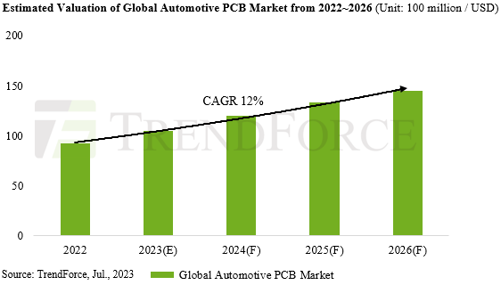With over half of the PCB industry's end-use applications in consumer electronics, the economic slowdown has had a more pronounced impact on the PCB industry compared to other components, especially when end-market demand has yet to show a significant recovery.
Despite this downturn, however, the automotive PCB market is expected to see a countervailing growth trajectory, primarily driven by the continuous rise in global EV penetration and the increasing electrification of vehicles.
TrendForce is predicting a 14% annual increase in the automotive PCB market, reaching a value $10.5 billion in 2023 and accounting for 13% of the total PCB market, which is up from 11% in 2022. By 2026, this figure is expected to grow to $14.5 billion, increasing its share of the total PCB market to 15%. This growth indicates a projected CAGR of 12% from 2022 to 2026.
EV adoption is a significant growth driver for the automotive PCB market, given average PCB values for a BEV are around 5 to 6 times that of a conventional fuel vehicle. Over half of these PCBs are installed in the BEV's control system, which houses the battery management system connected via a wire harness. Moreover, the growing popularity of automotive lightweighting is leading to a gradual shift toward the use of flexible printed circuits, which will further increase the PCB within the electric control system.
The rise of autonomous driving tech and its growing adoption rate, which means the integration of more cameras, radars, and other electronic devices, is also expected to further boost the automotive PCB sector.
In the automotive space, PCBs mostly rely on 4 to 8-layer boards; autonomous driving systems often adopt higher-priced HDI boards, which are triple in price. HDI boards used in light detection and ranging systems, equipped in L3 and more advanced autonomous driving systems, can cost tens of dollars and are a major contributor to the automotive PCB market’s future growth in value.
Looking at the types of PCBs, 4 to 8-layer boards are expected to account for about 40% of the total automotive PCBs by 2023, falling to 32% by 2026. In contrast, the proportion of HDI boards is projected to increase from 15% to 20%, and the proportion of FPC boards from 17% to 20%.
Additionally, according to TrendForce, the percentage of thick copper and RF boards will rise from 8% and 8.8% to 9.5% and 10.8%, respectively, while the proportion of lower-priced single and double-layer boards is predicted to decrease from 11.2% to 7.7%.













